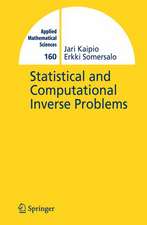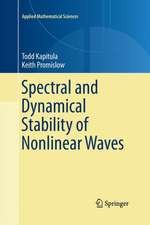Basic Structures of Function Field Arithmetic
Autor David Gossen Limba Engleză Paperback – 18 noi 1997
Preț: 788.90 lei
Preț vechi: 962.06 lei
-18% Nou
Puncte Express: 1183
Preț estimativ în valută:
150.98€ • 157.04$ • 124.64£
150.98€ • 157.04$ • 124.64£
Carte tipărită la comandă
Livrare economică 14-28 aprilie
Preluare comenzi: 021 569.72.76
Specificații
ISBN-13: 9783540635413
ISBN-10: 3540635416
Pagini: 444
Ilustrații: XIII, 424 p.
Dimensiuni: 155 x 235 x 23 mm
Greutate: 0.64 kg
Ediția:1998
Editura: Springer Berlin, Heidelberg
Colecția Springer
Locul publicării:Berlin, Heidelberg, Germany
ISBN-10: 3540635416
Pagini: 444
Ilustrații: XIII, 424 p.
Dimensiuni: 155 x 235 x 23 mm
Greutate: 0.64 kg
Ediția:1998
Editura: Springer Berlin, Heidelberg
Colecția Springer
Locul publicării:Berlin, Heidelberg, Germany
Public țintă
ResearchCuprins
1. Additive Polynomials.- 1.1. Basic Properties.- 1.2. Classification of Additive Polynomials.- 1.3. The Moore Determinant.- 1.4. The Relationship Between k[x] and k{?}.- 1.5. The p-resultant.- 1.6. The Left and Right Division Algorithms.- 1.7. The ?-adjoint of an Additive Polynomial.- 1.8. Dividing A1 by Finite Additive Groups.- 1.9. Analogs in Differential Equations/Algebra.- 1.10. Divisibility Theory.- 1.11. The Semi-invariants of Additive Polynomials.- 2. Review of Non-Archimedean Analysis.- 3. The Carlitz Module.- 3.1. Background.- 3.2. The Carlitz Exponential.- 3.3. The Carlitz Module.- 3.4. The Carlitz Logarithm.- 3.5. The Polynomials Ed(x).- 3.6. The Carlitz Module over Arbitrary A-fields.- 3.7. The Adjoint of the Carlitz Module.- 4. Drinfeld Modules.- 4.1. Introduction.- 4.2. Lattices and Their Exponential Functions.- 4.3. The Drinfeld Module Associated to a Lattice.- 4.4. The General Definition of a Drinfeld Module.- 4.5. The Height and Rank of a Drinfeld Module.- 4.6. Lattices and Drinfeld Modules over C?.- 4.7. Morphisms of Drinfeld Modules.- 4.8. Primality in F{?} and A.- 4.9. The Action of Ideals on Drinfeld Modules.- 4.10. The Reduction Theory of Drinfeld Modules.- 4.11. Review of Central Simple Algebra.- 4.12. Drinfeld Modules over Finite Fields.- 4.13. Rigidity of Drinfeld Modules.- 4.14. The Adjoint of a General Drinfeld Module.- 5. T-Modules.- 5.1. Vector Bundles.- 5.2. Sheaves and Differential Equations.- 5.3. ?-sheaves.- 5.4. Basic Concepts of T-modules.- 5.5. Pure T-modules.- 5.6. Torsion Points.- 5.7. Tensor Products.- 5.8. The Tensor Powers of the Carlitz Module.- 5.9. Uniformization.- 5.10. The Tensor Powers of the Carlitz Module redux.- 5.11. Scattering Matrices.- 6. Shtukas.- 6.1. Review of Some Algebraic Geometry.- 6.2. The ShtukaCorrespondence.- 7. Sign Normalized Rank 1 Drinfeld Modules.- 7.1. Class-fields as Moduli.- 7.2. Sign Normalization.- 7.3. Fields of Definition of Drinfeld Modules.- 7.4. The Normalizing Field.- 7.5. Division Fields.- 7.6. Principal Ideal Theorems.- 7.7. A Rank One Version of Serre’s Theorem.- 7.8. Classical Partial Zeta Functions.- 7.9. Unit Calculations.- 7.10. Period Computations.- 7.11. The Connection with Shtukas and Examples.- 8. L-series.- 8.1. The “Complex Plane” S?.- 8.2. Exponentiation of Ideals.- 8.3. ?-adic Exponentiation of Ideals.- 8.4. Continuous Functions on ?p.- 8.5. Entire Functions on S?.- 8.6. L-series of Characteristic p Arithmetic.- 8.7. Formal Dirichlet Series.- 8.8. Estimates.- 8.9. L-series of Finite Characters.- 8.10. The Question of Local Factors.- 8.11. The Generalized Teichmüller Character.- 8.12. Special-values at Negative Integers.- 8.13. Trivial Zeroes.- 8.14. Applications to Class Groups.- 8.15. “Geometric” Versus “Arithmetic” Notions.- 8.16. The Arithmetic Criterion for Cyclicity.- 8.17. The “Geometric Artin Conjecture”.- 8.18. Special-values at Positive Integers.- 8.19. The Functional Equation of the Special-values.- 8.20. Applications to Class Groups.- 8.21. The Geometric Criterion for Cyclicity.- 8.22. Magic Numbers.- 8.23. Finiteness in Local and Global Fields.- 8.24. Towards a Theory of the Zeroes.- 8.25. Kapranov’s Higher Dimensional Theory.- 9. ?-functions.- 9.1. Basic Properties of the Carlitz Factorial.- 9.2. Bernoulli-Carlitz Numbers.- 9.3. The ?-ideal.- 9.4. The Arithmetic ?-function.- 9.5. Functional Equations.- 9.6. Finite Interpolations.- 9.7. Another ?-adic ?-function.- 9.8. Gauss Sums.- 9.9. The Geometric ?-function.- 10. Additional Topics.- 10.1. The Geometric Fermat Equation.- 10.2.Geometric Deligne Reciprocity and Solitons.- 10.3. The Tate Conjecture for Drinfeld Modules.- 10.4. Meromorphic Continuations of L-functions.- 10.5. The Structure of the A-module of Rational Points.- 10.6. Log-algebraicity and Special Points.- References.
Recenzii
From the reviews:"The book...is a thorough and very readable introduction to the arithmetic of function fields of one variable over a finite field, by an author who has made fundamental contributions to the field. It serves as a definitive reference volume, as well as offering graduate students with a solid understanding of algebraic number theory the opportunity to quickly reach the frontiers of knowledge in an important area of mathematics...The arithmetic of function fields is a universe filled with beautiful surprises, in which familiar objects from classical number theory reappear in new guises, and in which entirely new objects play important roles. Goss' clear exposition and lively style make this book an excellent introduction to this fascinating field." MR 97i:11062
Caracteristici
A new and fascinating area of math * The author is a fundamental contributor to the field * The first systematic treatment of this subject * Introduces vital areas of current research * Clear exposition, lively style.













